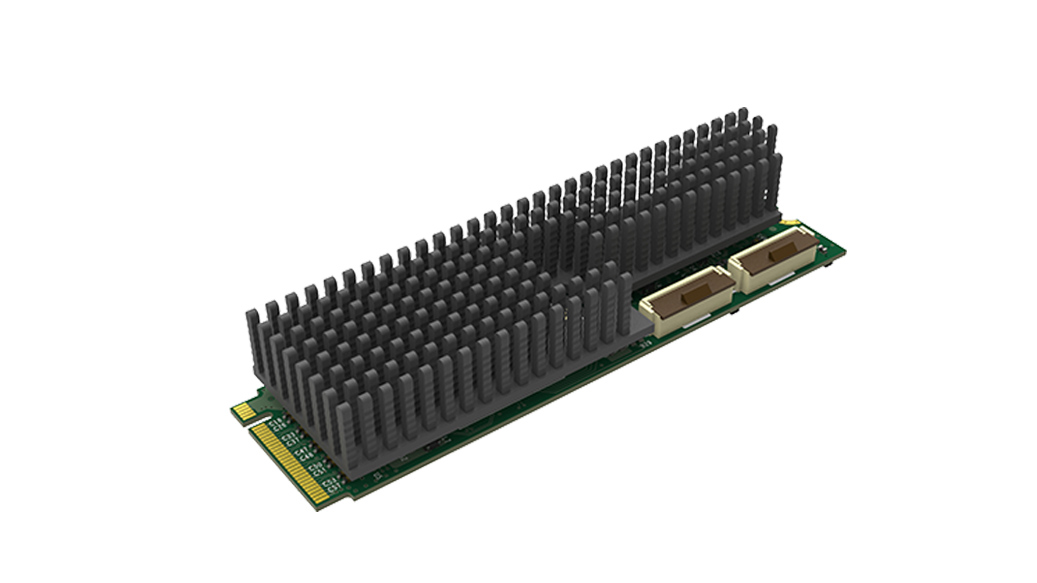M.2 HDMI capture card provides dual 2K video input — works in any PCIe 2.0 or later slot
Magewell provides an alternative for those who don't like USB solutions.

With many motherboard manufacturers sacrificing smaller PCIe x8, x4, and x1 slots on modern boards, the humble M.2 slot is finding new life beyond solid state drives (SSDs). Magewell, a company known for its video capture solutions, has created the Eco Capture Dual HDMI M.2 card, a compact M.2-based device that can be used for video capture. It supports dual 2K video inputs, as indicated by the name.
Superficially, the device resembles a typical M.2 2280 SSD, with a green PCB and a black heatsink on top. It also includes two SHD connectors and comes bundled with two SHD-to-HDMI Type-A cables. According to early testing by Interfacing Linux, the device does not come with any mounting hardware for the HDMI cable ends, but you can find cheap ones from Amazon or MODDYI.

Designed specifically for embedded systems and small form factor PCs, the device offers dual-channel 2K HDMI capture with an M.2 interface utilizing the PCIe 2.0 x4 lanes. With a maximum power draw of just 4.17W, the approach not only seems energy-efficient, but it also eliminates the need for full-sized PCIe cards. The product page indicates that the capture card makes use of FPGA-based video processing, and claims to provide high-quality up/down/cross-scaling, picture controls, and color space conversion without putting a strain on the host system's CPU.
The card supports image capture resolutions up to 2048x2160, or video capture at up to 144 frames per second. However, the actual capture frame rate can be limited depending on the PCIe bandwidth and resolution. A specific example of 1920x1080 at up to 80 FPS is listed on the specifications page.
A key benefit of the Eco Capture series is its software support. The device works with almost all versions of Windows and Linux, and there's additional driver support for ARM — specifically the Nvidia Jetson TX1 and TX2. It also offers support for native video APIs like DirectShow, DirectKS, Wave API/DirectSound/WASAPI, V4L2, and ALSA.
The Eco Capture Dual HDMI M.2 card is listed at $385, and is currently available on Amazon, B&H Photo, and other online resellers. Magewell has a wide range of options under its Eco Capture series. For instance, we previously covered the Eco Capture HDMI 4K Plus M.2 and Eco Capture 12G SDI 4K Plus M.2. Introduced back in 2023, these cards are similar to the Eco Capture Dual HDMI M.2 card but can support up to 4K capture at 60 frames per second.
Follow Tom's Hardware on Google News to get our up-to-date news, analysis, and reviews in your feeds. Make sure to click the Follow button.
Get Tom's Hardware's best news and in-depth reviews, straight to your inbox.

Kunal Khullar is a contributing writer at Tom’s Hardware. He is a long time technology journalist and reviewer specializing in PC components and peripherals, and welcomes any and every question around building a PC.
-
edzieba A nice alternative to the Blackmagic Decklink Micro, which requires HDMI to HD-SDI adapters (though it'll still likely work out cheaper even with the adapters unless you populate all 3 inputs). If you only need a single input, the Desklink Micro Recorder has a single HDMI input for around half the price (and half the m.2 card length).Reply -
ThisIsMe The product is okay, but please don’t perpetuate the use of meaningless buzz terms like “2k” when describing capabilities, performance, or any other metric. It’s not an actual standard and often used when a product doesn’t fully support higher standard resolutions/refresh rates so they make up some crazy abomination and call it 2k.Reply -
edzieba Reply
Technically, "2K" is a standard (as is "4K"): both are DCI standards. The problem is that DCI 2K is 2048 x 1080, which is not what 2K is being used to refer to here - likewise, DCI 4k is 4096 x 2160, not the 3840 x 2160 it is commonly used to refer to (which is actually a different standard: UHD).ThisIsMe said:The product is okay, but please don’t perpetuate the use of meaningless buzz terms like “2k” when describing capabilities, performance, or any other metric. It’s not an actual standard and often used when a product doesn’t fully support higher standard resolutions/refresh rates so they make up some crazy abomination and call it 2k.
Which makes discussing DCI files endlessly annoying, as you need to keep specifying "no, I don't mean 2K , I mean actual 2K!".